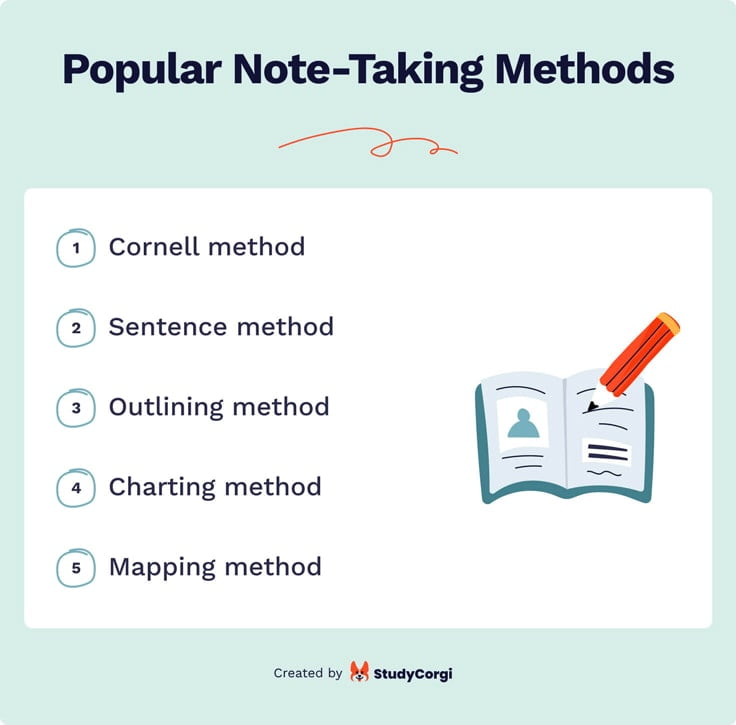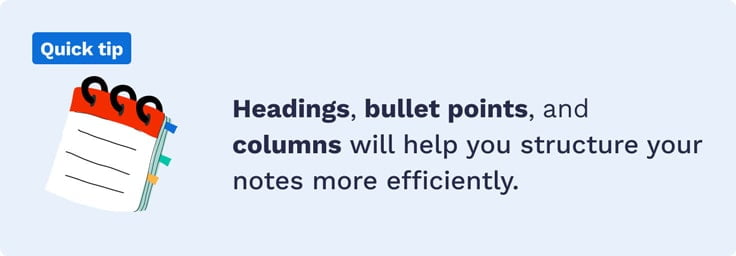🔥 Benefits of Our Note Generator
Our notes generator is a fantastic study tool with many advantages:
| 💸 Completely free | Use one of the best online apps at no cost and save money! |
|---|---|
| 🚀 AI-based | Our tool has cutting-edge AI at its core that can make perfect notes on any topic and subject. |
| 🤩 User-friendly | Our app is so intuitive and straightforward that you will master it instantly! |
| ⏱️ Saves time | Organizing notes can be a daunting task. Thanks to our tool, you won’t have to waste your precious time and energy on it. |
🤖 How to Use Our Note Generator
Take 3 easy steps to organize your study notes:
- Paste your text into the empty field.
- Choose the number of points you want to have.
- Press “Generate” and get the results!
✍️ Why You Should Take Study Notes
Research shows that note-taking is one of the core elements of the study process. There are many reasons for that. Here are the most prominent ones:
- Taking notes will significantly improve your ability to recall and comprehend information.
- You’ll be able to better reflect on the things you hear during lectures.
- You'll pay more attention to the lecture’s contents.
- Making connections between topics will come more naturally to you.
📌 Study Notes Generator: Note-Taking Methods
Taking notes by simply transferring information on paper is good, but sometimes it won’t do. What if your teacher is talking too fast or using unfamiliar terms? For these and other reasons, researchers have developed unique methods of note-taking. Let’s review them and analyze their advantages and disadvantages.

Cornell Method
The Cornell method offers a structured style for organizing notes. It’s based on using keywords for different subtopics in a text.
| 🛠️ How to use |
|
|---|---|
| 👍 When to use | The Cornell method is perfect for almost any type of lecture. |
| ✅ Advantages | Your notes will be well-organized and structured. |
| ❌ Disadvantages | It takes time to learn how to use this method correctly. |
Sentence Method
This approach of taking notes could be helpful if your classes are fast-paced and cover a lot of material. It requires you to write down the critical points on a new line with each topic. This lets you note a lot of information and helps you determine what information is worth recording.
| 🛠️ How to use |
|
|---|---|
| 👍 When to use |
|
| ✅ Advantages |
|
| ❌ Disadvantages | It may be difficult to distinguish between essential and minor points when you re-read the notes later. |
Outlining Method
This is one of the simplest methods for taking notes. Essentially, you record a text’s summary. Most people use this approach naturally without even knowing.
| 🛠️ How to use |
|
|---|---|
| 👍 When to use | This method is excellent when learning complicated subjects like physics or math. |
| ✅ Advantages | The outlining method will make it easier for you to pay attention to the information you’re receiving. |
| ❌ Disadvantages | It can take more time to figure out your notes later. |
Charting Method
This method focuses on capturing the connections between different aspects of the lecture’s topic.
| 🛠️ How to use |
|
|---|---|
| 👍 When to use | It’s best for lectures coming at a rapid pace. |
| ✅ Advantages |
|
| ❌ Disadvantages | Before using this method, you must have some basic knowledge of the subject. |

Mapping Method
Mapping is a note-taking technique that connects facts and concepts by providing a graphical representation.
| 🛠️ How to use |
|
|---|---|
| 👍 When to use | Use mapping when your lecture is difficult and extensive. |
| ✅ Advantages | Reviewing your map will allow you to make connections between different aspects of the topic quickly. |
| ❌ Disadvantages |
|
🔝 How to Create Notes from Any Text: Top Tips
Now that you know what methods can be used for taking notes, it’s time to learn how to use them effectively. We’ve prepared a handful of excellent tips that will help you master the art of note-taking. Check them out!
| Come prepared. | Make sure you have a notebook with plenty of pages. Remember to bring your pen, a pencil, and highlighters of different colors to emphasize important points. If you prefer to take notes on a PC, ensure its battery is charged. You want to be able to summarize every important lecture fully! |
|---|---|
| Check the board. | If you can’t keep up with your professor’s speech, try checking the board: teachers often summarize their important statements there. We also recommend writing down the contents of presentation slides, if there are any. |
| Use dates. | Dates will help you quickly navigate your notes, saving a lot of time. |
| Use signs and abbreviations. | Come up with a system of signs for commonly used words. It will allow you to take notes quickly and follow the fast tempo of the lecture. If you choose this strategy, we advise you to make a key to your abbreviations and stay consistent. |
| Record only essential things. | While writing, do your best to separate minor facts from important information. Otherwise, your notes will become a mess. |
| Leave some space. | Always remember that you might need to edit your notes or add some extra information. Make sure that you have some space left for that. |
| Use your own words. | If you want your notes to be useful, make them readable. Use easy-to-understand language, avoid complex grammar, and don't be afraid to ask your lecturer to explain complex terms. |
| Try various tools. | Our online note generator can help you make notes quickly and effectively. Integrate it into your academic life and use it to your advantage! |
We hope that you’ve enjoyed this article! Check our free tool and try it the next time you attend a lecture. It will help you write excellent notes and study better.
Stuck with a business assignment? Try our PESTEL analysis tool and 7S model template.
❓ Study Note Generator Online FAQ
❓ Is There a Website That Can Summarize Text?
Some websites can summarize your text. But there is no reason to use them when there is StudyCorgi's app! It works online without the need to download anything to your PC or register an account. Try our generator and see for yourself.
❓ Is There an App That Summarizes Text?
StudyCorgi’s free note generator is one of the best online apps for summarizing lectures. It has the most advanced AI and works quickly and effectively. With our generator, your notes will always be nicely structured and organized.
❓ Is There an AI That Can Summarize Text?
Our free note summarizer has ultra-smart AI. It can work with any subject and topic. Besides, it generates perfect results for free. Try it yourself and save your time and energy!
❓ How Do I Make a Note from Text?
You can use one of the following 5 methods: outlining, concept map, Cornell, sentence, or charting. Each of them has unique characteristics and is suitable for particular situations. You can also try our online app to generate notes from any text. It’s a universal tool for all subjects and topics. It will create great notes that you can use for your study.
🔗 References
- Effective Note-Taking in Class – UNC Learning Center: The University of North Carolina at Chapel Hill
- Benefits of Notetaking?: Austin Community College
- Note-Taking: Science, Strategies & Tips: Oregon State University
- Note-taking: Miami University
- Common Note-taking Methods: University of Tennessee at Chattanooga
- The Best Note-Taking Methods & Strategies: Box Blog
- The Definition and Most Popular Methods of Note Taking: ThoughtCo